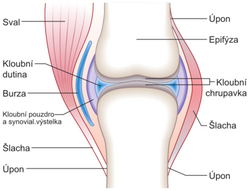Tumours of the joints
These tumors often arise both directly from the joint and from surrounding structures. In the former case, we distinguish synovial osteochondromatosis, vilonodular pigmented synovitis, and synovial sarcoma. Surrounding structures may give rise to hemangioma, lipoma, fibroma or neurofibroma.
Synovial osteochondromatosis[edit | edit source]
This is a benign finding of multiple intrasynovial chondromas that may ossify from the center of the lesion. They appear as oval deposits in the synovial membrane, causing a nodularly thickened joint surface. The tumor is sharply demarcated and may rarely malignize into chondrosarcoma. It causes mobility disturbances, so-called joint mice, due to the detachment of the synovial membrane with cartilaginous nodules.
Vilonodular pigmented synovitis[edit | edit source]
It is a diffuse giant cell tumor in the synovial lining of tendon sheaths, completely benign. It arises from thickening of the synovial membrane, which is villous and nodularly thickened on the surface. Brown pigmentation is typical hemosiderin. Treatment is by extirpation of the tumor, which prevents destruction of the joint. Histologically, we find multiplied synoviocytes A and B.
Synovial sarcoma (malignant synovialioma)[edit | edit source]
It is a high-grade malignant tumor of young adulthood, also referred to as soft tissue carcinosarcoma (based on the expression of epithelioid features). It can occur anywhere, most commonly around large joints (typically the knee), which is how it got its name, but it does not arise from synovial cells and has nothing to do with the joint other than its localization. The basis of its origin is translocation with the formation of a fusion transcript.
We distinguish:
- monophasic' - jelly-like, fleshy, less differentiated; if it is formed only by spindle cells, it is called monophasic spindle cell, and if it is formed only by glandular cells, it is a glandular sarcoma
- Biphasic' - composed of spindle and glandular mucous-forming cells, similar to endometrial cells
The tumor often recurs and metastasizes to the lung. Therapy is difficult - resection is necessary; responds poorly to chemo- and radiotherapy.
References[edit | edit source]
Related articles[edit | edit source]
References used[edit | edit source]
- POVÝŠIL, Ctibor – STEINER, Ivo – DUŠEK, Pavel. Special Pathology : Basisübungen für alle Sportarten. 2. edition. Prague : Galén, 2007. 430 pp. ISBN 978-807262-494-2.

